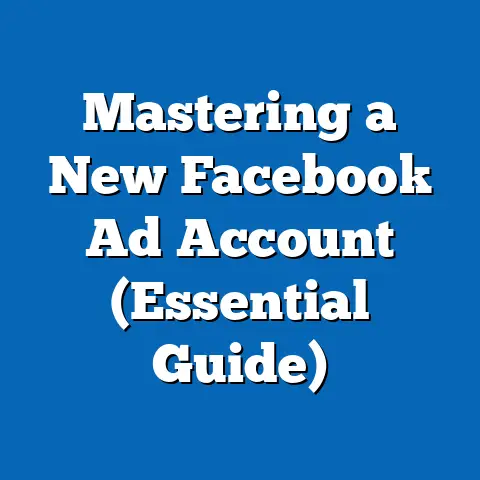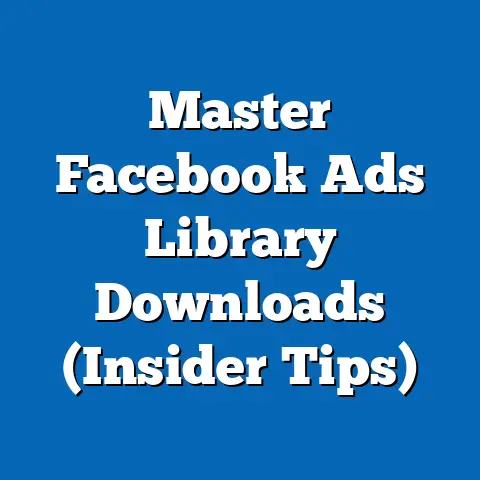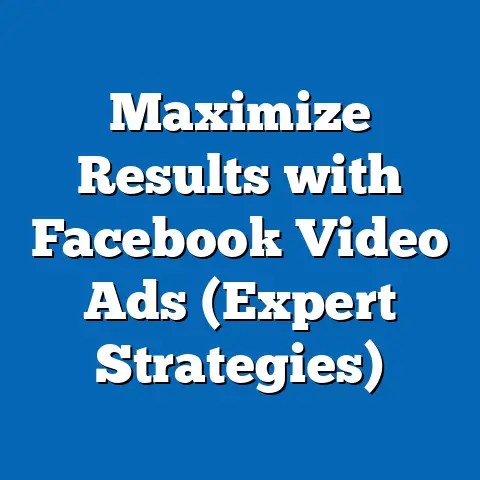Boost Camera Ads on Facebook (Proven Strategies)
Have you ever watched a film and been completely captivated by the visuals? I think of “The Secret Life of Walter Mitty,” where Ben Stiller’s character, a life photo editor, embarks on an extraordinary adventure. His trusty camera becomes more than just a tool; it’s a portal to new experiences and a way to connect with the world. That’s the kind of magic we want to create with your camera ads on Facebook – transforming a simple product into an unforgettable experience.
Facebook, with its billions of users, is a goldmine for businesses in the photography and camera niche. The platform’s visual nature aligns perfectly with the aesthetics of your products. Imagine showcasing the crystal-clear resolution of your latest DSLR to an audience of passionate photographers, or the rugged durability of an action camera to adventure-seeking travelers. The potential is immense.
Understanding the Facebook Advertising Landscape
Before diving into the specifics, let’s get a clear picture of the Facebook advertising landscape. It’s not just about creating an ad; it’s about understanding the ecosystem in which your ad will live and breathe.
Overview of Facebook Advertising
Facebook ads have come a long way since their humble beginnings. What started as simple text-based ads has evolved into a sophisticated platform offering a range of ad formats, targeting options, and analytics tools. In 2023, Facebook reported over 10 million active advertisers, highlighting its importance as a marketing channel. More importantly, these advertisers are seeing results. Statista reports that Facebook’s ad revenue continues to climb, indicating that businesses find value in the platform.
For camera brands, this means unparalleled opportunities. Consider these ad formats:
- Carousel Ads: Perfect for showcasing multiple camera models, lenses, or accessories. Each card can feature a different product with its own headline, description, and link.
- Video Ads: An excellent way to demonstrate camera features, such as image stabilization, low-light performance, or creative shooting modes.
- Slideshow Ads: A cost-effective way to create engaging visual stories using a series of static images.
- Collection Ads: Ideal for e-commerce brands, allowing users to browse and purchase products directly from the ad.
Why do these formats matter? Because they allow you to present your products in a visually appealing and informative way, capturing the attention of potential customers who are scrolling through their feeds.
Target Audience Identification
Who are you trying to reach with your camera ads? This is a crucial question that needs a well-defined answer. You can’t simply target “everyone” and expect great results. You need to identify and segment your target audience based on their interests, demographics, and behaviors.
Here are some potential target audience segments for camera ads:
- Professional Photographers: They are looking for high-end equipment, advanced features, and exceptional image quality.
- Hobbyist Photographers: They are passionate about photography but may have a limited budget. They are interested in user-friendly cameras and creative accessories.
- Travelers: They need durable and portable cameras that can capture their adventures.
- Parents: They want easy-to-use cameras to capture their children’s milestones.
- Content Creators: They are looking for cameras that can record high-quality videos for their YouTube channels or social media platforms.
Facebook’s Audience Insights tool is your secret weapon for gathering data about these potential customers. This tool allows you to explore the demographics, interests, and behaviors of people on Facebook. You can analyze their age, gender, location, education level, job titles, and even their favorite pages and activities.
For instance, if you’re targeting travel photographers, you might find that they are interested in travel blogs, national parks, and outdoor gear brands. This information can help you refine your targeting and create ads that resonate with their specific interests.
Takeaway: Know your audience! Don’t skip this step. Use Facebook’s Audience Insights tool to gather data and create detailed customer profiles.
Visual Storytelling
Photography is all about storytelling. It’s about capturing moments, emotions, and experiences. Your camera ads should reflect this. They should not just showcase your products; they should tell a story that resonates with your audience.
Think about films like “Life of Pi” or “A Beautiful Mind.” These films evoke powerful emotions through visuals, creating a lasting impression on the viewer. You can do the same with your camera ads.
Here are some tips for creating compelling visual narratives:
- Focus on the benefits, not just the features: Instead of simply listing the camera’s specifications, show how those features can help your audience capture better photos or videos.
- Use authentic imagery: Avoid stock photos. Use real photos taken with your cameras to showcase their capabilities.
- Tell a story: Create a narrative that connects with your audience’s emotions. Show how your cameras can help them capture their dreams, adventures, or precious moments.
- Keep it concise: Attention spans are short. Get your message across quickly and effectively.
Takeaway: Don’t just show your cameras; tell a story. Connect with your audience’s emotions and inspire them to capture their own stories.
Crafting Compelling Ad Content
Now that you understand the landscape and your audience, it’s time to craft compelling ad content that grabs attention and drives results. This involves both the written word and the visual elements.
Ad Copywriting Techniques
Copywriting is an art. It’s about using words to persuade, inform, and engage your audience. Here are some proven copywriting strategies tailored for camera ads:
- Focus on the emotional appeal: Tap into your audience’s passion for photography. Use words that evoke emotion, such as “capture,” “create,” “explore,” and “discover.”
- Highlight clear benefits: Emphasize the advantages of using your cameras. What problems do they solve? What opportunities do they unlock?
- Use a strong call to action: Tell your audience what you want them to do. Use clear and concise calls to action, such as “Shop Now,” “Learn More,” or “Get Started.”
- Keep it short and sweet: People are scrolling quickly. Get your message across in as few words as possible.
- Use numbers and statistics: Data can be very persuasive. Highlight key features, such as “24MP sensor,” “4K video,” or “10fps burst shooting.”
- Create a sense of urgency: Use words like “limited time offer” or “while supplies last” to encourage immediate action.
Let’s look at some examples of successful ad copy from leading camera brands:
- Canon: “Capture your world in stunning detail with the EOS R5. Experience unparalleled image quality and groundbreaking video capabilities.”
- GoPro: “Live the adventure. Capture the moment. Share the stoke. GoPro makes it easy to document your life’s greatest moments.”
- Sony: “Unleash your creativity with the Alpha 7 III. Experience full-frame performance in a compact and lightweight body.”
Notice how these examples focus on the emotional appeal, highlight clear benefits, and use strong calls to action.
Takeaway: Words matter! Use proven copywriting techniques to craft compelling ad copy that resonates with your audience.
Visual Elements
In the world of camera ads, visuals are king. High-quality images and videos are essential for showcasing your products and capturing the attention of potential customers.
Here are some tips for creating stunning visual elements:
- Use professional photography: Invest in high-quality product photos that showcase your cameras in their best light.
- Demonstrate camera features: Use videos to demonstrate key features, such as image stabilization, low-light performance, or creative shooting modes.
- Show real-world applications: Use photos and videos that show your cameras being used in real-world scenarios.
- Highlight the camera’s design: Showcase the camera’s aesthetics, ergonomics, and overall design.
- Use a consistent style: Maintain a consistent visual style across all your ads to reinforce your brand identity.
For example, a video ad demonstrating the image stabilization of a camera could show someone running while filming, with the footage remaining smooth and steady. This visually demonstrates the benefit of the feature in a way that words simply can’t.
Takeaway: Invest in high-quality visuals that showcase your cameras’ capabilities and capture the attention of your audience.
Utilizing User-Generated Content
Customer reviews, testimonials, and user-generated photos can be incredibly powerful in enhancing the credibility of your camera ads. People trust the opinions of other customers more than they trust advertising claims.
Here are some ways to utilize user-generated content:
- Feature customer reviews in your ads: Highlight positive reviews that mention specific benefits or features of your cameras.
- Share customer testimonials: Create video testimonials featuring satisfied customers sharing their experiences with your cameras.
- Use user-generated photos: Feature photos taken by your customers with your cameras. This is a great way to showcase the camera’s image quality and real-world performance.
- Run contests and giveaways: Encourage customers to share their photos and videos using your cameras. This can generate a lot of user-generated content and increase brand awareness.
For example, you could run a contest asking customers to submit their best photos taken with your camera, with the winner receiving a prize. This not only generates user-generated content but also encourages engagement and brand loyalty.
Takeaway: Leverage the power of user-generated content to build trust and credibility with your audience.
Ad Targeting and Optimization Strategies
Creating great ad content is only half the battle. You also need to target the right audience and optimize your ads for maximum performance.
Advanced Targeting Techniques
Facebook offers a range of advanced targeting techniques that can help you reach the right people with your camera ads.
Here are some of the most effective techniques:
- Custom Audiences: Create custom audiences based on your existing customer data, such as email lists, website visitors, or app users. This allows you to target people who are already familiar with your brand.
- Lookalike Audiences: Create lookalike audiences based on your custom audiences. This allows you to reach people who are similar to your existing customers.
- Retargeting: Retarget people who have visited your website or interacted with your ads. This allows you to re-engage potential customers who have already shown an interest in your products.
- Demographic Targeting: Target people based on their age, gender, location, education level, and job titles.
- Interest-Based Targeting: Target people based on their interests, such as photography, travel, or outdoor activities.
- Behavioral Targeting: Target people based on their behaviors, such as their purchase history, online activity, or device usage.
For example, you could create a custom audience of people who have visited your website and viewed your camera product pages. You could then retarget these people with ads that showcase those specific cameras, offering them a special discount or promotion.
Takeaway: Don’t rely on broad targeting. Use Facebook’s advanced targeting techniques to reach the right people with your camera ads.
A/B Testing
A/B testing is the process of comparing two versions of an ad to see which one performs better. This is an essential part of optimizing your ad campaigns.
Here are some elements you can A/B test:
- Ad copy: Test different headlines, descriptions, and calls to action.
- Visual elements: Test different images, videos, and ad formats.
- Targeting parameters: Test different audiences, demographics, and interests.
- Placement: Test different ad placements, such as Facebook News Feed, Instagram Feed, or Audience Network.
Here’s a step-by-step guide on how to conduct effective A/B tests for camera ads:
- Define your hypothesis: What do you expect to happen? For example, “I believe that using a video ad will result in a higher click-through rate than using a static image ad.”
- Create two versions of your ad: Change only one element at a time. For example, change the headline but keep everything else the same.
- Run your ads simultaneously: Make sure both ads are running at the same time, targeting the same audience.
- Track your results: Monitor the performance of each ad, paying attention to key metrics such as click-through rate, conversion rate, and cost per acquisition.
- Analyze your results: Determine which ad performed better and why.
- Implement your findings: Use the winning ad in your future campaigns.
Takeaway: Don’t guess what works best. Use A/B testing to optimize your ads and improve your results.
Analyzing Performance Metrics
Tracking your ad performance is crucial for understanding what’s working and what’s not. Here are some key performance indicators (KPIs) to track:
- Click-Through Rate (CTR): The percentage of people who saw your ad and clicked on it. A higher CTR indicates that your ad is engaging and relevant to your audience.
- Conversion Rate: The percentage of people who clicked on your ad and completed a desired action, such as making a purchase or filling out a form. A higher conversion rate indicates that your ad is effective at driving results.
- Cost Per Acquisition (CPA): The cost of acquiring a new customer through your ad campaign. A lower CPA indicates that your ad campaign is efficient.
- Engagement Metrics: Metrics such as likes, comments, and shares indicate how engaging your ad is.
- Reach: The number of unique people who saw your ad.
- Frequency: The average number of times each person saw your ad.
Facebook Ads Manager provides a wealth of data that you can use to analyze your ad performance. You can also use third-party analytics tools to gain deeper insights.
Takeaway: Data is your friend! Track your ad performance and use the insights to optimize your campaigns.
Leveraging Facebook Ad Features for Maximum Impact
Facebook offers a range of features that can help you maximize the impact of your camera ads.
Using Facebook Pixel
Facebook Pixel is a small piece of code that you can place on your website to track user interactions and conversions. This allows you to:
- Track website visitors: See who is visiting your website and what pages they are viewing.
- Track conversions: See who is making purchases or filling out forms on your website.
- Retarget website visitors: Retarget people who have visited your website with relevant ads.
- Optimize your ads: Use Facebook Pixel data to optimize your ads for conversions.
Here’s a guide on setting up and utilizing Facebook Pixel for camera ads:
- Create a Facebook Pixel: Go to Facebook Ads Manager and create a new Pixel.
- Install the Pixel on your website: Follow Facebook’s instructions to install the Pixel code on your website.
- Set up conversion tracking: Define the events you want to track, such as purchases, form submissions, or page views.
- Create custom audiences: Create custom audiences based on your website visitors and conversion data.
- Retarget website visitors: Retarget people who have visited your website with relevant ads.
- Optimize your ads: Use Facebook Pixel data to optimize your ads for conversions.
Takeaway: Facebook Pixel is a powerful tool that can help you track user interactions, retarget website visitors, and optimize your ads for conversions.
Dynamic Ads for E-commerce
Dynamic ads are a type of ad that automatically showcases a range of products based on user interests and browsing behavior. This is particularly useful for e-commerce brands that sell a wide variety of cameras and accessories.
Here’s how dynamic ads work:
- Upload your product catalog: Upload your product catalog to Facebook.
- Create a dynamic ad template: Create a template that will be used to generate your dynamic ads.
- Set up targeting: Target people who have shown an interest in your products or who have visited your website.
- Facebook automatically generates ads: Facebook will automatically generate ads based on your product catalog and targeting parameters.
For example, if someone visits your website and views a specific camera model, they may see a dynamic ad for that camera model on Facebook.
Takeaway: Dynamic ads are a great way to showcase a range of camera products and target people who have shown an interest in your products.
Integration with Instagram
Facebook and Instagram are both owned by Meta, and they are tightly integrated. This means you can run your Facebook ads on Instagram as well.
Here are some benefits of integrating Facebook and Instagram ads:
- Wider reach: Reach a larger audience by advertising on both platforms.
- Cohesive campaigns: Create cohesive campaigns that leverage both platforms effectively.
- Simplified management: Manage your ads from a single platform.
- Cross-platform retargeting: Retarget people who have interacted with your ads on one platform on the other platform.
For example, you could run a Facebook ad that promotes a new camera model and then retarget people who clicked on that ad with an Instagram ad that showcases user-generated content featuring that camera model.
Takeaway: Don’t limit yourself to Facebook. Integrate your Facebook ads with Instagram for a more comprehensive advertising strategy.
Real-World Case Studies and Success Stories
Let’s take a look at some real-world case studies and success stories to see how leading camera brands are using Facebook ads effectively.
Case Study 1: Canon
Canon is a well-known camera brand that has been using Facebook ads effectively for years. Their target audience includes both professional and amateur photographers, and they use a variety of ad formats and targeting techniques to reach them.
Here are some key strategies Canon has used:
- High-quality visuals: Canon uses stunning visuals to showcase the image quality and features of their cameras.
- Targeted messaging: Canon tailors their messaging to different audience segments. For example, they might use different messaging for professional photographers than they use for amateur photographers.
- Interactive ads: Canon uses interactive ad formats, such as quizzes and polls, to engage their audience.
- Retargeting: Canon retargets people who have visited their website with relevant ads.
Canon’s Facebook ad campaigns have resulted in increased brand awareness, website traffic, and sales.
Case Study 2: GoPro
GoPro is another successful camera brand that has been using Facebook ads effectively. Their target audience includes adventure enthusiasts and content creators, and they use a unique approach to advertising that focuses on adventure and community.
Here are some key strategies GoPro has used:
- User-generated content: GoPro relies heavily on user-generated content in their ads. This helps to build trust and credibility with their audience.
- Adventure-focused messaging: GoPro’s messaging focuses on adventure, excitement, and the thrill of capturing life’s greatest moments.
- Community building: GoPro uses Facebook to build a community around their brand. They encourage customers to share their photos and videos using GoPro cameras.
- Interactive contests: GoPro runs interactive contests that encourage customers to share their stories and experiences.
GoPro’s Facebook ad campaigns have resulted in increased brand awareness, customer engagement, and sales.
Lessons Learned
What can we learn from these case studies? Here are some key takeaways:
- Know your audience: Tailor your messaging and targeting to different audience segments.
- Use high-quality visuals: Invest in stunning visuals that showcase your cameras’ capabilities.
- Leverage user-generated content: Build trust and credibility by featuring customer reviews, testimonials, and photos.
- Focus on the emotional appeal: Connect with your audience’s passion for photography and adventure.
- Build a community: Use Facebook to build a community around your brand.
Takeaway: Learn from the success of leading camera brands and apply their strategies to your own Facebook ad campaigns.
Conclusion
Facebook ads offer a powerful way to enhance brand visibility and drive sales for camera products. By understanding the platform, crafting compelling ad content, targeting the right audience, and leveraging Facebook’s features, you can create campaigns that capture the imagination of potential customers and achieve your marketing goals.
Remember, just as every picture tells a story, every ad can create a compelling narrative that resonates with your audience. Embrace the strategies discussed in this guide, experiment with different approaches, and track your results. With dedication and creativity, you can unlock the full potential of Facebook ads and transform your camera brand into a visual storytelling powerhouse.
Now, I encourage you to share your own success stories or experiment with the strategies outlined in this article. What are your favorite Facebook ad techniques for camera brands? Let’s continue the conversation and learn from each other. Let’s make some magic happen!






